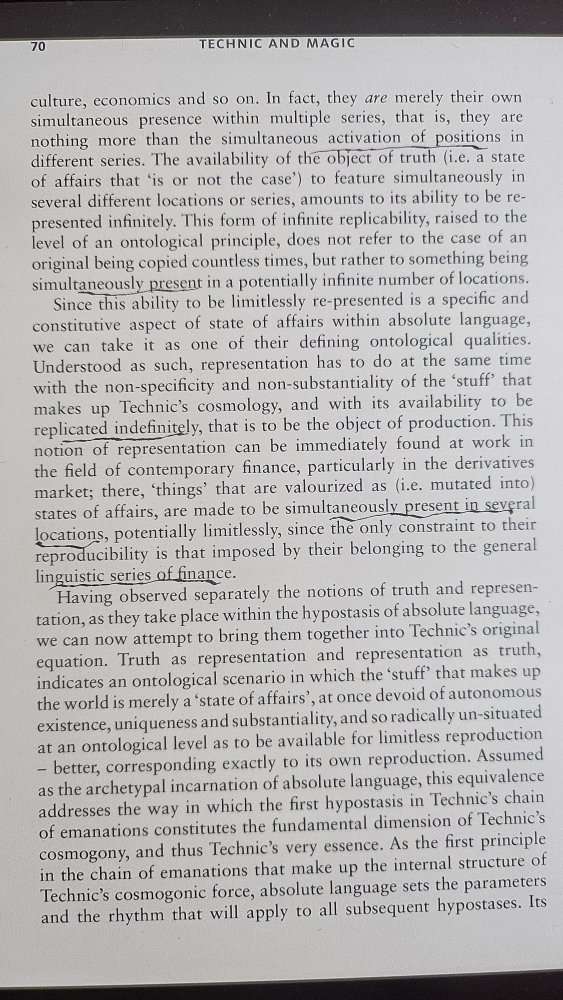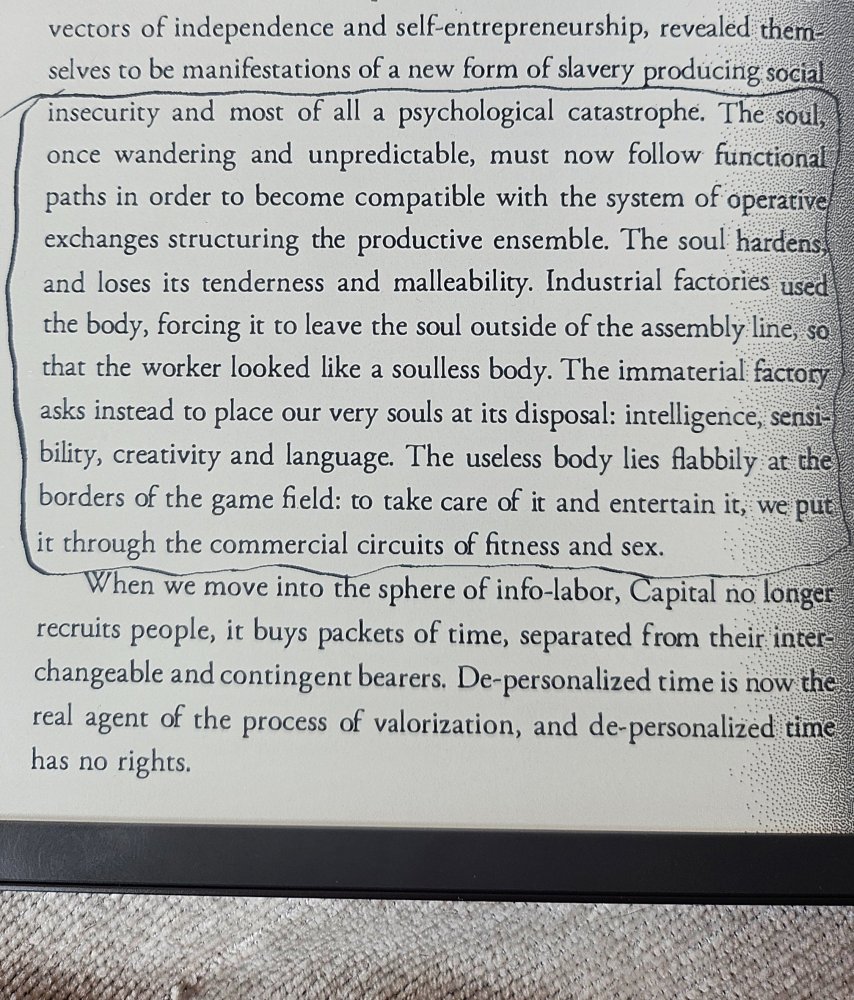-
Posts
2,264 -
Joined
-
Days Won
499
Everything posted by Kevin von Duuglas-Ittu
-
I've felt some pretty strong disillusionment as a photographer, which pretty much comes in line with the overall dilution of meaningfulness in digital communications, as everything gets stretched out into endless (truly endless) digital series, consumed in scrolls, catching affect-torquing algorithm effects (or not), much of it aligned to dopamine hits, which stresses us out into over-stimmed depression beasts. We take photos because this little fragment of reality...matters. And the art of the camera, its alchemy, is applying rites, practices and crafts to that image to bring that meaningfulness forth. To just dump that carved piece of the REAL into a knowledge mill, into a vast encryption pulverization is just fundamentally wrong, and deprives the photograph of the very sort of sacred (yes, sacred) life it was given. This is a fundamental crisis...and deeply affects even how I relate to my own images, or even the desire to take them. I've always felt that this problem is one of occasional aesthetics, that there must be forms out there, waiting to be created, which deny some aspects of this digital pulverization. (This I suppose are what galleries are for, or printed prints on walls in homes...to forestall the profanation.) This problem is absolutely unresolved, but... This morning I began editing my photographs of Kru Hem at TDet99 from yesterday and the first two photographs really spoke to me. They spoke to me as a pair. Together, they held a symbolic form, I might say. So I asked myself, how in this digital time (I refuse Instagram...actually since my Instagram account suddenly vanished several years ago, for no reason at all, but also because its form for photographs is dead wrong), could I even present them as a Symbolic Form, as a Two? What would be in some sense homological to how it might be if they hung on a wall, framed, side by side? The question was a very simple one, one that instinctively felt had an answer...at least a partial answer. I imagined, just place them in relationship to themselves in video (video holding its own very serious, de-aestheticizing problems in the scroll), but do so using a feature that I believe is what made large screen cinema different. The secret to cinema's magic was that the size of the screen cannot be taken in in a single glance. The action may occur here or there, but there are always areas of the screen to explore, at any given moment in the flow of time. The viewing eye sculpts, as it selects attention, in the narrative. (This is something, a magic, that no longer operates within our world of small screens.) I just entered one of these photos and selected out frames within the frame, and placed them in tempo with the overall frame, mimicking in part some of the nature of cinematic magic. I have no idea how or if this changes how the images may be received and experienced in various digital flows and scroll/refreshes, within the pulverization mill which grinds our attention, packaged for exchange in markets, but it DID change how I related to my photographs themselves. The process pulled me into them, and brought the pleasure of the large files I'm able to shoot with. I love exploring the worlds and pieces of worlds within a single frame, so it made me happy with my art, it changed the possible within it, rather than de-spiriting it.
-
There is a decisive moment in Lynch's Mohulland Drive when Betty having aced her audition meets the director's eyes, as he is about to make his own decisive (necessary) compromise with his Desire, and she turns to run to the solipsism of her own Desire (refusing her own necessary compromise), only to head into the nightmare of her own Desire refusing her...that alternate reality which always runs parallel.
-
Chartri has one fundamental problem. The magical fighter was created by traditional Muay Thai, and he is trying with all his might to destroy traditional Muay Thai. He is left with only the simulation of magic, a hocus-pocus of increasingly untenable hype and fragmentation, as the intial borrowing of mesmerizing talent and skill ftom the tradion bleeds out, ages out, of his product. As fighting dumbs down in his vision of endless knockouts, his sport heads toward Bangla Stadium level performativity, the putting on of shows for the visitor...a visitor who ultimately becomes only him and his distortive vision, something erotic to distract and extract...while the culture of the sport and art wastes away. The magical fighter cannot be simulated. The human eye knows the difference.
-
There are two schools of thought on this. Padholding is now used, often, to teach techniques, but in Thailand's past it was much more of conditioning, rhythm-making training mechanism. Kaensak said it was used to "charge the battery". One reason why it could work in that way was because the kaimuay was full of training many other aspects of fighting, including lots of play-sparring, and timing building training. A better approach, given that kaimuay training has been somewhat lost to the sport, is to use padwork to build your own sense of control and rhythm taking, turning padwork much more into a dialogue. But...this takes an advanced, experienced padholder, usually a former experienced stadium fighter, who can work in that way. You want to build and change intensities, work at different distances, etc. One of the most important (and neglected) things in fighting is control over distance, and varying tempo/intensity. When you have a good padman, these things can be work with.
-
The grassroots of Thailand's Muay Thai, consistent of networks of small kaimuay gyms and local side-bet fight scenes in the provinces are left with two impotent choices: join the stream of endless labor supply to Entertainment aggression fighting, getting knocked out for content...or, enter Bangkok gambled stadia fighting, and lose to big gym name fighters the promoters are building, carefully sculpting your muay so fit within a conservative spectrum of fighting...ie, when you lose, it can't be blameable on a singular, pointed out mistake you have made. Blame has to be dispersive, because you and your gym have little social power. In either case, its the grassroot kaimuay who are feeding Capital Muay. The problem is that Capital, in its scissoring of the sport, pushing it towards rudiments, strips it of its complexity, a complexity that traditionally reached its apex in the Capital (in the 1970s-1990s). The source of this complexity though likely resides in the provinces themselves. That argument:
-
Trad Muay Thai Not Dead Yet. This Incredibly Skilled fight between 9 year olds. Femeu spacing and timing, linking strikes with eyes & rhythm, not in memorized combos, rounds of Muay Khao fighting, fluid knees upon knees. Old School Ruup, Sanae, art & dominance. It's beautiful that this kind of developed muay can still happen in Thailand, it tells us that grassroots the art, style and knowledge is still living, despite the onslaught embrace of Entertainment values, mostly made for foreigners. Though, as can be seen in other young femeu fighters, as these young fighters grow into the Bangkok scene they will likely lose a lot of this art, as betting pressures and a general conservative, simplifying cultural force will rob much of the fluency and expression. At this age they reflect very significant aspects of Golden Age fighting, things very hard to find in the sport now, but the trends of the sport then strip away the freedom and continuity. We have a historical condition now where the art & really sophistication of the sport's legacy exists in the provinces, whereas in the Capital Thailand's Muay Thai has be contorted by capital interests, both in its Entertainment varieties (made for the non-Thai tourist/consumer) AND by the compressed, illiberal, online-fueled betting culture of stadium fighting. Entertainment Muay Thai dumbs down the vocabulary and expressive value of the sport, attempting to create a violence-oriented, casuals product (altering the sophistication of the sport, and its essential Thai dominance over aggression DNA); and stadium betting Muay Thai, because of the oversized power of gambler influence, drains away the complexity of the art, as fighters and small gyms are forced into stylistic straight jackets, avoiding risk-taking, and creative intricacy. Broadly speaking Entertainment fighters know, in the extreme, their job is to get knocked out (a notable Thai Entertainment fighter said this to me), and grass roots fighters in stadium Muay Thai know their job is to not lose face, leaving no room for the development of the kinds of skills and expression that we see in this fight.
-
Reading Berardi, I become convinced, that we must find a way to island the knowledge, protect it from its encryption. The only thing I can think of...is a place...not a means of expression or communication. A topos. But these are at most gyms or museums. It does not come to me yet. But, we must prevent or forestall, retard encryption.
-
It's crazy. Sylvie dropping knowledge from her years of experience in Thai gyms, a slowly evolved observation on the hidden dimensions of hierarchy and fighter evolution, and people in comments proposing theories on what is REALLY happening, you know, based on no connection to kaimuay culture. We live in a time when the simulation of knowledge (and perspective) is the purpose of exchange. Heading toward pure simulcrum. They haven't a clue, she gave them a clue. The internet is anti-knowledge.
-
I believe we need to take an anti-knowledge stance towards Muay Thai, in this Age. This is to say, anything that measures is to be shunned. I've not always done that, but I'm coming to see that simply is not the direction. Cadence is an interesting question. Not the cadence that measures, in the sense of the unfeeling cadence, the cadence which cannot see. But also, and more importantly, every spatial coordinate, anything that maps on neutral space. Any gridding.
-
The Knowledge Mill There is a very interesting dilemma that has gradually arisen, as the totalization of cognitive Capitalism takes its hold on the world, which is that so much of our information sphere has become a knowledge mill. This is to say, we all work producing knowledge and perspectives to feed into the mill, day and night, such that the meaning of our knowledge, our experiences, becomes asymptotically less and less. It just wants to be fed. And we grist it all, feeding it back in. As the producer of perhaps the greatest documentation of a fighting art, in the history of the planet, and art full of nuance, culture and history, as well as great efficacy, how does one keep it from just being ground up by the mill and losing all meaning? Just another set of details, coordinates of interest, to be mapped and ultimately colonized by pure consumption? We've purposely made much of the documentation hard to digest for such a mill. Hour long videos of narrative structure that force investment and discovery by the viewed. We've made it hard to mine...but still is lacking, other than this mode of resistance, an appropriate expression and conversation of that knowledge, something that honors its meaningfulness. I've felt myself grow sensitive to this milling, and feeds are populated by advice and social-credit expertise, increasingly a flood of nonsense (from a certain perspective). Just let the mill mill, I say. But, its more than that. It needs a positive form, resistant to that churning mouth of it all.
-
Simondon and the Infinite grammatical positions of Becoming from the same work I see some parallels in transition a fighter can make between gyms in Thailand, in years as they elapse, as a fighter you ARE your techniques (not of striking, but of training). Avatars of oneself unfold, in series of successions. In the passage below swap out "technology" with techniques-of-training, perhaps, to make the most sense of where I am heading.
-
Looking for gym recs/cost info!
Kevin von Duuglas-Ittu replied to Henry Van Der Laan's topic in Gym Advice and Experiences
Kem's Muay Thai in the Khaoyai Mountains below Korat would be a once-in-a-lifetime experience for someone in your position I think.
Footer title
This content can be configured within your theme settings in your ACP. You can add any HTML including images, paragraphs and lists.
Footer title
This content can be configured within your theme settings in your ACP. You can add any HTML including images, paragraphs and lists.
Footer title
This content can be configured within your theme settings in your ACP. You can add any HTML including images, paragraphs and lists.






